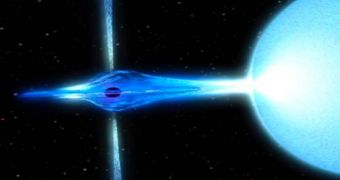Previously, astronomers believed that only black holes are capable to emit powerful X-ray jets, but a new study conducted at the Penn State University shows that, in fact, any class of object may be able to some extent to form powerful X-ray jets. A newly discovered neutron star seems to present features relatively similar to that of a black hole, which lays base for the prediction that X-ray emissions are actually generated by powerful gravitational fields.
A neutron star represents the remnant of a dead star, which was compacted into a dense sphere formed mostly of neutron particles during a supernova explosion. Circinus X-1 is a binary system, located about 20,000 light years away from Earth. It consists of an ordinary massive star, with a mass seven times that of our Sun, and a neutron star orbiting around it. This so-called 'microquasar' presents clear evidence that it is emitting strong X-ray jets, the first of this type of objects, other than black holes, to determine bright emissions of light.
Niel Brandt, Professor of Astronomy and Astrophysics at Penn State University, argues that microquasars could be approximated to their more massive cousins, the quasars, which are amongst the brightest objects in the whole universe. Both have extreme gravitational fields, with which they convert large masses of matter into long, powerful X-ray jets. Nonetheless, astronomers previously believed that extreme gravitational fields are not enough to determine such emissions, and the fact that black holes don't actually have a solid surface might play a key role.
While studying the percentage of the energy extracted from the absorbed material in relation to the energy emitted through X-ray jets, Penn State astronomers approximated that the conversion rates between the two different class of objects are almost the same.
The observations have been made with the Chandra X-ray Space Telescope while trying to explain the diffuse lobes of radio emissions originating from the vicinity of the Cirnius X-ray binary system. It is now clear that the radio emissions are determined by the filtered X-ray light through interstellar gas, which might also explain why similar radio wavelengths are observed near massive quasars, such as those in the galactic nuclei of galaxies.
An odd characteristic of the Cirnius X-ray binary system, is that the neutron star seems to emit two X-ray jets separated by a 30 degree angle, extending five light years into space, fact that could be explained by the presence of a wider X-ray jet than previously thought. A second possibility is that the neutron star is emitting a single narrow X-ray jet, but due to a violent wobble in its spin, the jet seems to appear at different places in different times. If indeed the feature is determined by the precession movement of the neutron star, then this particular X-ray emission would be one of the narrowest and longest jets ever discovered in a binary system.

 14 DAY TRIAL //
14 DAY TRIAL //